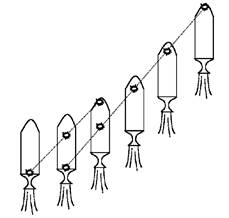


 الفيزياء الكلاسيكية
الفيزياء الكلاسيكية
 الكهربائية والمغناطيسية
الكهربائية والمغناطيسية
 علم البصريات
علم البصريات
 الفيزياء الحديثة
الفيزياء الحديثة
 النظرية النسبية
النظرية النسبية
 الفيزياء النووية
الفيزياء النووية
 فيزياء الحالة الصلبة
فيزياء الحالة الصلبة
 الليزر
الليزر
 علم الفلك
علم الفلك
 المجموعة الشمسية
المجموعة الشمسية
 الطاقة البديلة
الطاقة البديلة
 الفيزياء والعلوم الأخرى
الفيزياء والعلوم الأخرى
 مواضيع عامة في الفيزياء
مواضيع عامة في الفيزياء|
Read More
Date: 10-10-2016
Date: 3-10-2016
Date: 24-11-2016
|
Head to Toe
Can relativitic effects make your feet age more slowly than your head?
Answer
Yes, your feet and toes age slower than your head. That is, whenever you are standing or sitting, a clock at the altitude of your head will tick faster than an identical clock at the altitude of your toes. The ambient gravitational field affects the tick rate of all clocks in the same way. A clock will tick fastest at rest in an inertial reference frame. The difference between clock rates in different gravitational environments is normally minuscule but measurable and, to a first approximation, the time interval between ticks differs by (δr/r) GM/rc2 ΔT, where δr is the altitude difference, M is Earth’s mass, r is the radial distance from the center of Earth, G is the gravitational constant, c is the speed of light, and ΔT is the time interval between ticks on the reference clock. Substituting r = 6.37 × 106 m and dr ~ 1.5 m produces a value of 1.6 × 10–16 ΔT, an incredibly small change in rate. Over a lifetime of about 80 years, the head becomes about 0.4 microsecond older than the toes.
To understand the effect of gravitation on the clock rate, we can utilize the equivalence between an accelerating rocket frame and being in a uniform gravitational field. Consider two light flashes sent from the bottom of the accelerating rocket to its top, as shown in the animation diagram from the view of our inertial reference frame with respect to the stars. The two light flashes are one second apart in our frame but arrive at the top of the rocket three seconds apart. Why? Because the top has moved away from the approaching light flash with the appropriate acceleration value. Therefore the frequency of arrival is lower than the starting frequency. In a stroke of genius, Einstein realized that the only reason for different flash frequencies would be if the clock at the top ticked at a different rate than the

identical clock at the bottom. Therefore, gravitation makes time run slow.
Is there a place where one can put a clock so that the time interval between ticks becomes infinite? Yes, near a black hole, at the event horizon.



|
|
|
|
تفوقت في الاختبار على الجميع.. فاكهة "خارقة" في عالم التغذية
|
|
|
|
|
|
|
أمين عام أوبك: النفط الخام والغاز الطبيعي "هبة من الله"
|
|
|
|
|
|
|
قسم شؤون المعارف ينظم دورة عن آليات عمل الفهارس الفنية للموسوعات والكتب لملاكاته
|
|
|